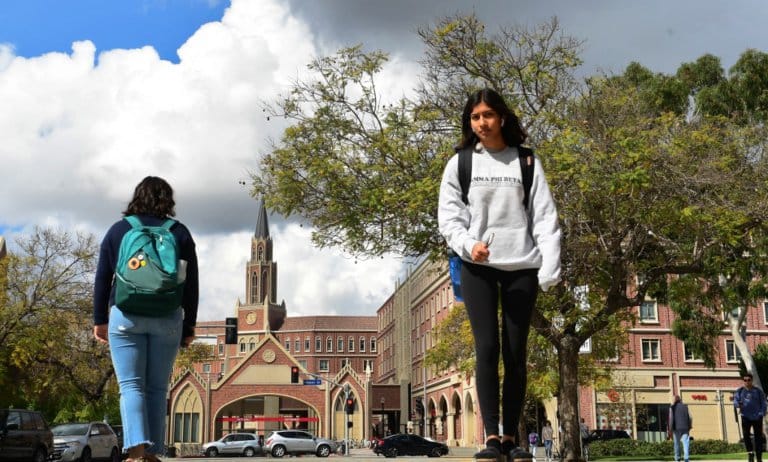
Flexible curriculum. Home to world-class institutions. Easy access to picturesque sights such as the Golden Gate Bridge, Grand Canyon, Yosemite National Park, and many more. These are a few reasons why millions of international students choose to study in the US.
Studying here, however, is expensive. Students spent an average of US$99,417 for their degree, according to a report by HSBC in 2018.
A US degree can be much cheaper than that — if you know where to look and what to focus on. Here’s all you need to know to do just that – from picking the right university, choosing the right course, knowing the right time to apply for your student visa, and many more:
Step-by-step: How to study in the US for cheap
1. Check the education requirements
If English is not your first language, you need to pass an English language proficiency test. The tests that most US higher education institutions commonly accept are:
- Cambridge Assessment English (CAE)
- International English Language Testing System (IELTS)
- Test of English as a Foreign Language (TOEFL)
Each university requires you to achieve a specific CAE, IELTS, or TOEFL score. For example, Adelphi University requires a minimum English proficiency test score of 80 for TOEFL and 6.5 for IELTS.
Passing this test is important. Without it, you won’t be able for a visa as one of its criteria is you must be first accepted at an accredited US institution.
Remember to complete and submit your SAT and ACT exams too. Most colleges and universities still require them.
View this post on Instagram
2. Pick a college/university, choose your programme
Not every programme is charged the same price. Each uni also has their own fee structure. Based on our research, two institutions offer affordable options to international students:
California State University
All campuses have also been ranked among the top 100 “Best Bang for the Buck” universities in the West, according to Washington Monthly. Financial aid options include grants, loans, scholarships, and many more.
Southeast Missouri State University
Southeast Missouri State University is proof that high quality doesn’t equate to high cost. International students pay as low as US$15,585 annually to pursue a bachelor’s degree.
Choose from more than 170 degree programmes, including 129 undergraduate majors. These include degrees in accounting, computer science, dance, and more.
Pro tip #1: Remember that tuition fees will vary depending on the course. Choosing a professional bachelor’s degree in law, medicine, and engineering will cost more compared to business, language, or physical education majors since more resources are required to obtain the qualification.
Pro tip #2: In some US states, community colleges charge much lower tuition fees compared to four-years colleges or unis — these are states such as Nebraska, Kansas and Arkansas where tuition is around US$4,000. According to EducationData.org, the average community college tuition is US$8,210 for out-of-state students. After getting your associate’s degree from a community college, you can transfer to a university, with credits to get a bachelor’s degree. This saves you the cost of up to two years in a college or uni.
3. Research scholarships and financial aid services
Course fees. Living expenses. Budgets for night outs. These add up – and it can get costly.
Fortunately, finding a scholarship to study in the US is easy. Therese Riego proved this by securing three merit scholarships that funded her studies in the land of opportunities.
Need help searching for these scholarships? Here’s a list to help you out. Some scholarships cover tuition fees, while others cover your living and travelling expenses.
Check if you qualify for financial aid. For example, the admission committee at Columbia University considers how much financial aid a student requires when evaluating an application.

Reach out to graduates from the college or university you’re interested in to find out more about student life and admission requirements. Source: Justin Sullivan/Getty Images North America/Getty Images/AFP
4. Find out the university’s admission requirement
You’ve chosen your course and narrowed down your preferred institutions. Are you wondering what’s next?
It is time to check the college’s or university’s admission requirement. Here is a sample checklist to follow:
- Your high school transcript
- English language proficiency test
- SAT or ACT scores
- Proof of finances
- Personal statements or essays
- Letter of recommendation
- A copy of your passport
- Application fees
Reach out to graduates or staff from your chooses colleges or unis to learn more about the admission requirements.
5. Apply to universities
Complete your application online either through the school’s website or a third-party system such as the Common App (which is accepted by nearly 900 institutions). Some universities accept applications from Shorelight. You can create a Shorelight and Common App account for free.
Keep in mind the documents mentioned in the sample checklist. Some universities may require proof of financing for international students.
Did you also know that there are universities in the US that don’t have application fees? Click here to learn more.
6. Apply for scholarships
What sets US colleges and universities apart are the various scholarship options. There are academic, athletic, artistic, service-based scholarships or need-based financial aids.
Don’t limit yourself to scholarships offered by an institution. Consider external scholarships like the The Karsh International Scholarship too.
Before you submit your application, prepare your documents. Generally, you should have your:
- Personal statement
- Offer letter
- English language proficiency test scores
Pay attention to the scholarship application deadline and eligibility requirements. Only trust information sourced from the scholarship provider’s website.

Remember to apply for your visa after you get your offer letter. Source: Chris Delmas/AFP
7. Apply for your student visa
Once you have received your admission letter or email, look for any information that:
- Directs you to accept the offer
- Tells you how to receive the I-20 form
- Shows you the dates to arrive on campus for the beginning of classes.
For most colleges and universities, you must place a tuition (and possibly housing) deposit by a specific deadline to secure your spot.
After that, apply for your student visa. The magic combination to look out for is the F-1 student visa. This visa permits you to study at US universities or colleges with funding from friends, family, or yourself. You can also work part-time on campus for up to 20 hours per week when your academic term is in session.
The 1-20 form allows you to apply for this visa. Once you have received the form from your college or university, complete these four steps:
- Pay a US$350 SEVIS I-901 fee online (and keep your electronic SEVIS fee receipt)
- Apply for your non-immigrant visa (online DS-160 form)
- Schedule your visa interview at the US embassy or consulate
- Complete the interview
Looking for ways to ace your student visa interview? Click here for valuable tips.
8. Find out more about the city and housing options
Where you choose to live depends on what you prefer. If you like being minutes away from classes, want to join many student clubs, and have your wifi, electricity, Internet, and more sorted out for you, then choose on-campus housing.
If you prefer to be more independent, want to live with locals and be closer to the local town or city, then choose off-campus housing.
On average, students spend US$9,330 to US$13,620 on room and boarding for the 2021-22 academic year, following statistics from the College Board. Consider websites such as Uniplaces, Nestpick, and AmberStudent if you’re searching for proper off-campus housing. An off-campus, one-bedroom apartment might cost you around US$1,500 to US$1,800 per month. You can make this cheaper by living with roommates.
9. Plan your travel
Your college or uni will inform you of the right time to arrive. Many advise arriving early to familiarise yourself with the new environment. But this means you may have to pay more rent — to save money, try couchsurfing or arriving closer to the start of term.
Apart from booking your plane ticket, pay attention to two dates. Immigration regulations require you to arrive in the US no more than 30 days before your programme start date stated in your I-20 form. You must also arrive before your programme start date listed on the same document.
A few months before you’re set to fly, set up price alerts through Kayak or Google Flights to get deals emailed to you.
Once you arrive in the Land of Liberty, there are a few ways to travel from the airport:
- Airport shuttle pick-up service: Some universities offer a free airport shuttle service from the airport to your accommodation
- Trains
- Busses
- Taxi: They tend to be more expensive, but you won’t have to carry your luggage around.
- Uber: A popular ride-sharing app that is cheaper than a taxi
10. Set your budget
Setting a budget helps you to deal with the rising cost of living, manage your expenses and spend within your means.
On average, be prepared to spend US$10,000 to US$18,000 per year on housing, food, textbooks, travel, weather-appropriate clothing and entertainment. If you’re living in a bigger city, your cost of living will be higher.
While you can search for work on campus, the best budgeting apps, like Mint and Rakuten, can help you save and earn money at the same time.
When you’re in the US, here are some cheap stores to look out for:
- Dollar General – to buy a great selection of food and snacks
- TJ Maxx – for cheap brand-name clothing, shoes, and handbags
- Big Lots – Get a range of items for your college or university student’s needs for cheap










